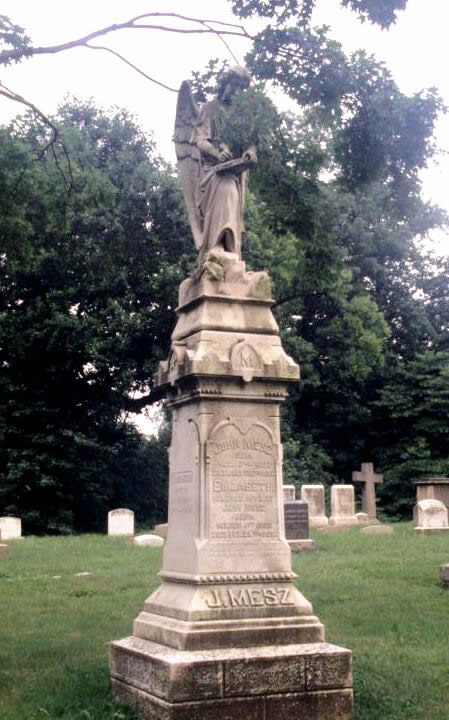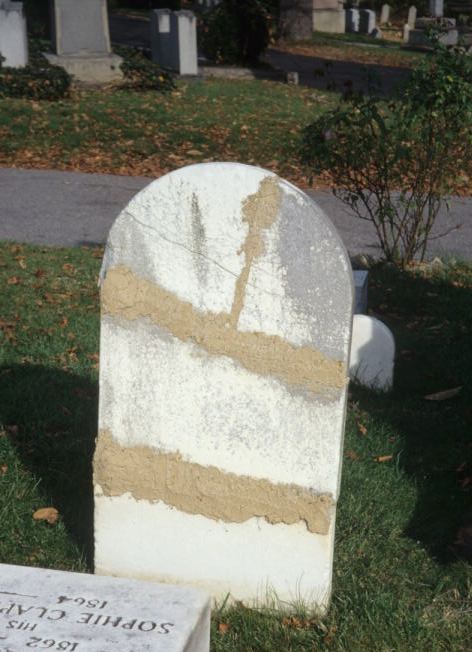The preservation of a cemetery or burial ground requires careful planning. In cemetery
preservation projects there is often the impulse to rush to treatment. Before any work
is carried out, first document, assess,
research and prioritize. Helpful resources are available on-line and in print.
 Encroaching tree emperils monument.
Encroaching tree emperils monument.
Document
Cemeteries are fragile; markers and inscriptions can disappear over time and there
may be losses due to vandalism, weathering and damage. Establish a record of the
resource in order to have baseline data. On a survey sheet document each grave site,
including monuments and other features such as footstones, curbing, cornerstones,
fences, plantings and overhanging trees. List the types of stone and other
materials, and assess the condition, noting damage, deterioration, vegetation overgrowth
and any drainage problems. The National Center
for Preservation Technology and Training website has a useful glossary for cemetery assessment.
Photograph the features and record inscriptions. Volunteers can accomplish the work,
ideally after training to ensure consistency in the data collected. Document and
assess the condition of all other features throughout the cemetery such as planters,
benches, fencing, walls, paths, and roadways. Document trees and plants, many of
which may be historic and original to the site. Enlist a horticultural or
garden club for identification and to provide sound landscape management advice.
Research
Check land records and archives to learn about the history of the site and its
associations, the people buried there, changes over time and boundaries. Burial
sites can extend beyond marked graves. For research assistance, see the
guide
to history research on the Maryland State Archives website.
Interpret
Cemeteries and burial grounds demonstrate our cultural values and heritage. As
educational resources in the community, they can be integrated into the curriculum at
all levels in areas such as science, math, art, history and social studies. Involve
the community in preservation activities.
 Unwise repair attempt.
Unwise repair attempt.
Prioritize
With the collected data, set priorities for work. Place high risk items, such as
leaning monuments and dead trees, ahead of cosmetic. Build in provisions for long
term maintenance. The repair and treatment of monuments should be the final steps in
the project. Cleaning is a low priority; it is often not necessary and has the
potential to cause damage. Respect the historic configuration and appearance of
the cemetery; for example, it may not be appropriate to introduce fencing if
the site was not fenced historically.
Seek Professional Assistance
Cemetery preservation professionals are available to help with all levels of the
project, including planning, documentation, survey and treatment. Enlist the
help of professionals with experience in appropriate treatments for historic
materials. Only trained conservators should repair monuments and sculpture.
Ask if they are members of professional organizations such as the
American
Institute for Conservation of Historic and Artistic Works (AIC). Ask if
they are insured. Require a written proposal detailed with work to be
done, materials to be used and references prior to hiring. Call all
references. Proposed work should conform to the
AIC
Code of Ethics and Guidelines for Practice; note the sections on preventive conservation, treatment
and documentation. See also the
Secretary of the Interior's Standards for the Treatment of Historic Properties.
Obtain Training
Seek out training opportunities for all aspects of the preservation project. Learn
to distinguish work that can be done by volunteers from that which requires
professional expertise. Provide training in appropriate landscape practices to work
crews. Avoid overuse of herbicides, as historic plants may be lost, bare soil
around monuments would cause instability, and the chemicals could damage the
stones. Hand clear, or use herbicides selectively on invasives such as poison
ivy. Power mowers and trimmers can leave scars on stone and ironwork; trimming is
best done by hand.
Maintain
Build provisions for maintenance into the preservation plan in order to avoid
wasted effort and expense. Establish a routine to monitor
the site, record conditions and note where repairs are needed. Set realistic priorities
for maintenance; for example, where it may not be possible or historically appropriate
to keep a large site mowed, paths could be maintained to provide access, with
overall mowing done less often.
A Few Words About Cleaning Headstones
- Cleaning is often not necessary and has the potential to cause damage. Do not
clean or scrub marble or other stone that is crumbling or sugared (if grains of
sand fall away when a hand is passed over the surface).
- Use the gentlest means: lots of water only and a soft, non-metallic brush that
you would use on your car. Keep the stone wet. Under-clean rather than over-clean.
- Never use bleach, household or abrasive cleaners, trisodium phospate (TSP),
alkaline cleaners, acids, power washers, power tools, or sand blasting. Bleach
and TSP introduce salts, which damage the stone and cause spalling. Water is safest.
- Stone acquires a usually harmless patina over time. Regular cleanings can result
in loss of surface. Do not scrub down to a clean new surface, as this
only provides a fresh place for biota to regrow.
- To safely clean biota from all types of stone, proprietary architectural
biocides are available. These kill biota and provide a
long-term residual effect; examples are D/2 or Enviro Kleen ReVive). Mix as directed, spray
on the surface, and do not scrub.
Biota will die and the stone will lighten up over time with weather.
- In most cases, an occasional rinsing of stones with a garden hose at low
pressure will keep soil and plant particles from taking hold and providing food
for biota to grow.